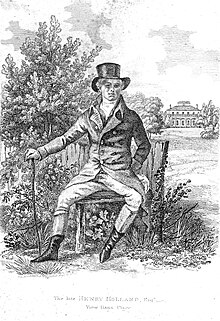Henry Holland (architect)
Henry Holland (born July 20, 1745 in Fulham , London, † June 17, 1806 in London ) was an architect of the British upper class in the 19th century. He was trained by Capability Brown , whose daughter he later married. Sir John Soane was one of his students.
The architect was born in Fulham, now London , and began his architectural work with the design of Brooks's Club, St. James's (1776–1778) with subsequent projects at the Theater Royal in Drury Lane and the Royal Opera House.
In 1777 Holland began developing a 360,000 m² area, the Hans Town . This area was leased by the Cadogan family. In this area, Holland laid out parts of Knightsbridge and Chelsea. Here you will find Sloane Street and Sloane Square , as well as Hans Place, Street and Crescent. These built-up areas quickly became one of the most fashionable areas in London.
From 1802 Holland converted the York House on Piccadilly Square into the Albany Apartments.
The original Naval Pavilion (1786–1787) in Brighton , Sussex, which was built for the Prince Regent and later King George IV , and the redesign of the neoclassical Carlton House , London (1783) are Holland's best-known works. This neoclassical design contrasted with the architect Robert Adams , who pursued a dissolute style.
Buildings (selection)
Dorothy Stroud set up Henry Holland's buildings in a book.
- 1771-1772: Battersea Bridge
- 1776-1778: Brooks's Club
Web links
Individual evidence
- ^ Dorothy Stroud : Henry Holland: His life and architecture . 1st ed. Country Life, 1966, ISBN 978-1-199-53948-9 , pp. 159 .
| personal data | |
|---|---|
| SURNAME | Holland, Henry |
| BRIEF DESCRIPTION | British architect |
| DATE OF BIRTH | July 20, 1745 |
| PLACE OF BIRTH | Fulham , London |
| DATE OF DEATH | June 17, 1806 |
| Place of death | London |
